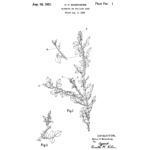Roses are Valentine’s Day’s signature flower. Indeed, these are the most often sent flower on the holiday and the subject of the first plant patent issued by the USPTO. This “Climbing Rose,” invented by Henry F. Bosenberg of New Jersey, is characterized by its champagne-colored roses and everblooming quality. Interestingly, Mr. Bosenberg was not even a plant breeder but rather, a landscape gardener. Under patent law, the inventor of a plant is the person who first appreciates its distinctive qualities and asexually reproduces it. Since this first plant patent in 1931, the USPTO has granted nearly 6,000 plant patents overall. Overall, roses account for over 4% of issued plant patents. In 2016 alone, 80 plant patents were granted for new and distinct types of roses. In 1944, John H. Bonhard from Illinois was the first to patent a carnation. The invention began as a pink carnation and was propagated through multiple generations to achieve a new variety known for early blooming, a rich bright “Castillian Red coloring,” and “unusually large blooms with heavy petalage.” Flowers and other Valentine’s-themed intellectual property constitute a popular category at the USPTO in the form of not only patents but also a number of trademark registrations. Hallmark owns trademark rights for its signature gold crown emblem. Moreover, Godiva and Russell Stover chocolates, and Sweethearts conversation heart candy are all covered by trademark registrations. Turns out, for these individuals and entities, all they need is love…and intellectual property rights. #omnilegalgroup #patents #trademarks #ValentinesDay
February 14, 2018

